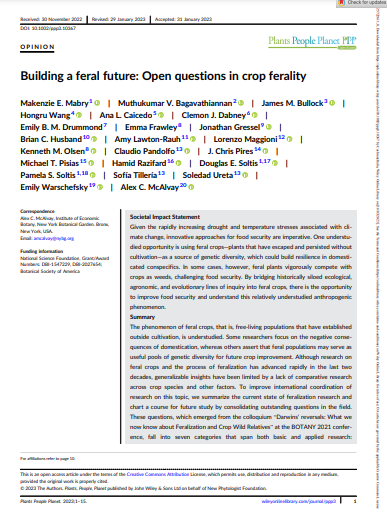The phenomenon of feral crops, that is, free-living populations that have established outside cultivation, is understudied. Some researchers focus on the negative consequences of domestication, whereas others assert that feral populations may serve as useful pools of genetic diversity for future crop improvement. Although research on feral crops and the process of feralization has advanced rapidly in the last two decades, generalizable insights have been limited by a lack of comparative research across crop species and other factors. To improve international coordination of research on this topic, we summarize the current state of feralization research and
chart a course for future study by consolidating outstanding questions in the field. These questions, which emerged from the colloquium “Darwins’ reversals: What we now know about Feralization and Crop Wild Relatives” at the BOTANY 2021 conference, fall into seven categories that span both basic and applied research: (1) definitions and drivers of ferality, (2) genetic architecture and pathway, (3) evolutionary history and biogeography, (4) agronomy and breeding, (5) fundamental and applied ecology, (6) collecting and conservation, and (7) taxonomy and best practices. These questions serve as a basis for ferality researchers to coordinate research in these areas, potentially resulting in major contributions to food security in the face of climate change.
Mabry, M.E.; Bagavathiannan, M.V.; Bullock, J.M.; Wang, H.; Caicedo, A.L.; Dabney, C.J.; Drummond, E.B.M.; Frawley, E.; Gressel, J.; Husband, B.C.; Lawton-Rauh, A.; Maggioni, L.; Olsen, K.M.; Pandolfo, C.; Pires, J. C.; Pisias, M.T.; Razifard, H.; Soltis, D.E.; Soltis, P.S.; Tillería, S.; Ureta, S.; Warschefsky, E.; McAlvay, A.C.

